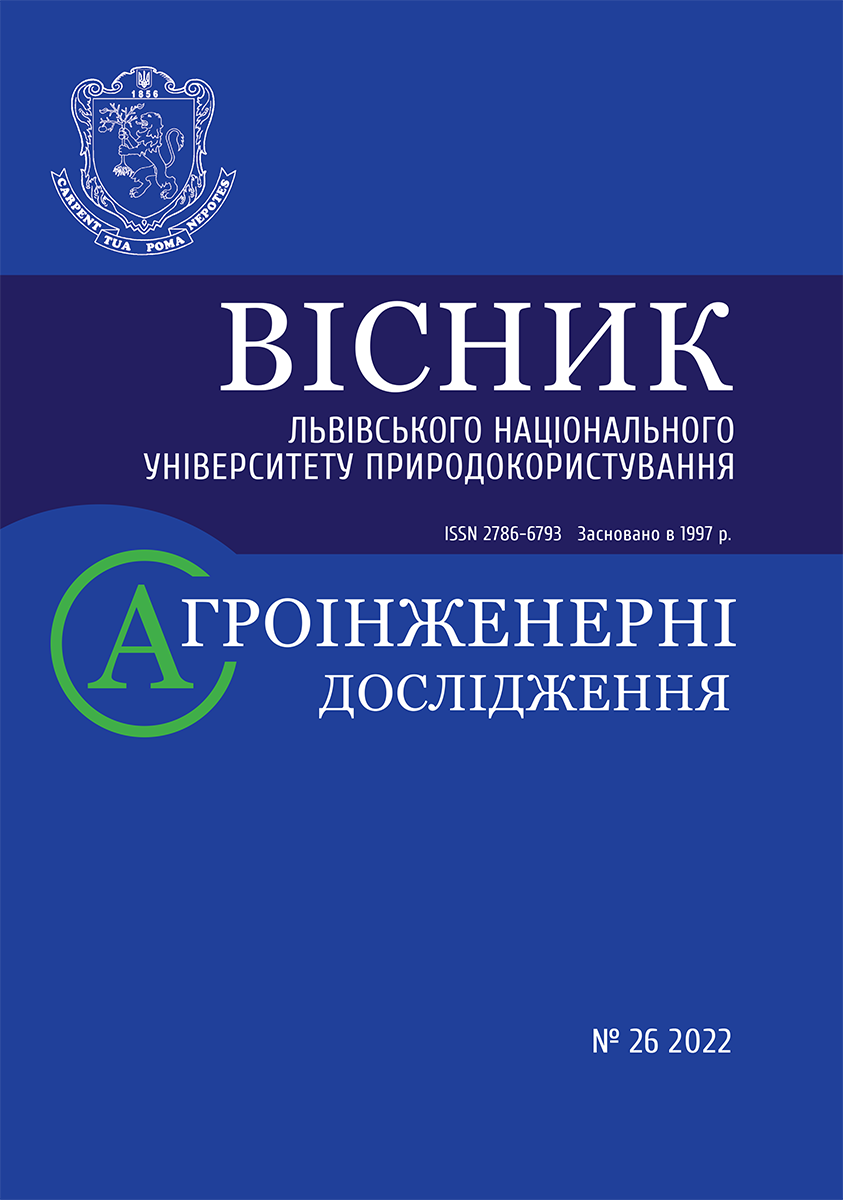System model of the digital transformation of rural territorial communities based on computational intelligence
DOI:
https://doi.org/10.31734/agroengineering2022.26.177Keywords:
digital transformation, rural communities, computational intelligence, modelAbstract
The article gives analysis of rural community activity. Scientific works devoted to digital transformation in various spheres of human activity are analyzed. The need to develop tools for solving problems of digital transformation of rural communities with the use of computational intelligence is substantiated. Twelve types of problems related to the development of rural communities on the basis of their digital transformation with the use of computational intelligence have been formulated. The ways to solve problems, which will ensure both the development of rural communities and individual processes that are implemented in them, are proposed. A system model of digital transformation of the process of procurement of food raw materials on the territory of rural communities with the use of computational intelligence is proposed. It provides for the implementation of seven levels of digital transformation of rural communities. Separate levels form four sub-cycles of digital transformation of rural communities. Each sub-cycle of digital transformation of rural communities provides the desired result and increases the efficiency of this process. A mathematical description of the complete cycle of digital transformation of the process of procurement of food raw materials in rural areas is done by using computational intelligence. The results of implementation of the subcycles of digital transformation of rural communities are defined. They form the basis of the required levels of digital transformation for each individual rural community, taking into account their capabilities. The proposed system model of digital transformation of the process of procurement of food raw materials is the basis for the development of tools to support management decisions in planning the processes of procurement of food raw materials in rural communities using computational intelligence. Further research should be conducted in the direction of developing tools for planning the process of procurement of food raw materials in rural communities using computational intelligence. The expediency of formulating tasks related to the development of rural communities on the basis of digital transformation with the use of computational intelligence is substantiated.
References
Bashynsky, О., Garasymchuk, I., Gorbovy, O., Vilchinska, D., & Dubik, V. (2020). Research of the variable natural potential of the wind and energy energy in the northern strip of the ukrainian carpathians. In 6th International Conference: Renewable Energy Sources (ICoRES 2019). E3S Web of Conferences 154, 06002.
Cugno, M., Castagnoli, R., & Büchi, G. (2021). Openness to Industry 4.0 and performance: the impact of barriers and incentives. Technological Forecasting and Social Change, 168, 120756. doi: 10.1016/j.techfore.2021.120756.
Kuziomko, V., Buranhulova, V., & Buranhulova, V. (2021). Mozhlyvosti vykorystannia shtuchnoho intelektu v diialnosti suchasnykh pidpryiemstv. Ekonomika ta suspilstvo, 32. doi: 10.32782/2524-0072/2021-32-67.
Kvitka, S., Novichenko, N., Husarevych, N., Piskokha, N., Bardakh, O., & Demoshenko, H. (2020). Perspektyvni napriamky tsyfrovoi transformatsii publichnoho upravlinnia. Aspekty publichnoho upravlinnia, 8(4), 129-146.
Pizhuk, O. I. (2019). Shtuchnyi intelekt yak odyn iz kliuchovykh draiveriv tsyfrovoi transformatsii ekonomiky. Ekonomika, upravlinnia ta administruvannia, 3(89), 41-46. doi: 10.26642/ema-2019-3(89)-41-46.
Razumei, H. Yu., & Razumei, M. M. (2020). Didzhytalizatsiia publichnoho upravlinnia yak skladnyk tsyfrovoi transformatsii Ukrainy. Publichne upravlinnia ta mytne administruvannia, 2 (25), 139-145. Retrieved from http://customs-admin.umsf.in.ua/archive/2020/2/27.pdf.
Romanov, V., Galelyuka, I., Voronenko, O., Kovyrova, O., Dzyadevych, S., & Shkotova, L. (2019). Smart Sensors and Computer Devices for Agriculture, Food Production Process Control and Medicine. In 29th International Conference on Computer Theory and Applications ICCTA 2019, 29-31 October 2019, Alexandria, Egypt (pp. 9-12). Alexandria.
Schneider, P. (2018). Managerial challenges of Industry 4.0: an empirically backed research agenda for a nascent field. Rev. Manag. Sci, 12 (3), 803-848. doi: 10.1007/s11846-018-0283-2.
Sydorchuk, A. V., Tryhuba, A. N., & Malanchuk, A. V. (2013). Otsenka tsennostey servisnyih programm agrarnogo proizvodstva. MOTROL. Commission of motori zation and enerqetics in aqriculture, 15 (4), 153-159.
Sydorchuk, O. V., Tryhuba, A. M., & Sholudko, P. V. (2010). Osoblyvosti planuvannia proektiv ta prohram ahrarnoho vyrobnytstva. In Upravlinnia proektamy: stan ta perspektyvy: Materialy VI Mizhnar. konf. (pp. 313-316). Mykolaiv: NUK.
Tryhuba, A. M., Tryhuba, I. L., Kondysiuk, I. V., & Koval, N. Ia. (2021). Planuvannia zmistu ta chasu vykonannia robit u hibrydnykh proiektakh iz vykorystanniam shtuchnykh neironnykh merezh. In Upravlinnia proektamy u rozvytku suspilstva: Upravlinnia proiektamy v umovakh pandemii COVID-19: Tezy dop. XVII Mizhnar. konf. (pp. 279-284). Kyiv: KNUBA.
Tryhuba, A., Ptashnyk, V., Tatomyr, A., Koval, N., Kondysiuk, I. (2021). Vykorystannia shtuchnykh neironnykh merezh dlia prohnozuvannia skladovykh hibrydnykh proektiv. In Teoriia i praktyka rozvytku ahropromyslovoho kompleksu ta silskykh terytorii: Materialy ХХІІ Mizhnar. nauk.-parkt. forumu, 5-7 zhovtnia 2021 r. (T. 2, ss. 96-100). Lviv: NNVK «ATB».
Tryhuba, A., Ratushny, R., Tryhuba, I., Koval, N., & Androshchuk, I. (2020). The Model of Projects Creation of the Fire Extinguishing Systems in Community Territories. Acta universitatis agriculturae et silviculturae mendelianae brunensis, 68, 2, 419-431.
Tryhuba, A., Tryhuba, I., Bashynsky, O., Kondysiuk, I., Koval, N., & Bondarchuk, L. (2020). Conceptual model of management of technologically integrated industry development projects. 15th International Scientific and Technical Conference on Computer Sciences and Information Technologies (CSIT), 2, 155-158.
Tryhuba, A., Tryhuba, I., Chubyk, R., Kondysiuk, I., Koval, N., & Paniura, Ya. (2020). Prohnozuvannia obsiahiv zahotivli syrovyny na terytorii hromad iz vykorystanniam shtuchnykh neironnykh merezh. Visnyk Lvivskoho natsionalnoho ahrarnoho universytetu: ahroinzhenerni doslidzhennia, 24, 143-151.
Tsyfrovi hromady: v Ukraini rozpochato realizatsiiu pilotnoho projectu z elektronnoho uriaduvannia v OTH. (2022). Retrieved from http://surl.li/chebl (Last accessed: 20.05.2022).
Yevsiukova, O. V. (2021). Tsyfrova spromozhnist terytorialnykh hromad v Ukraini: problemy ta perspektyvy. Derzhavne upravlinnia: udoskonalennia ta rozvytok, 6. Retrieved from http://www.dy.nayka.com.ua/?op=1&z=2084 (Last accessed: 25.05.2022).
Тryhuba, A. (2021). Computer model of resource demand planning for dairy farms. Independent Journal of Management & Production (Special Edition ISE, S&P), 12(3), 138-149. Retrieved from http://www.ijmp.jor. br/index.php/ijmp/article/view/1531/1971 (Last accessed: 21.05.2022).
Тryhuba, А., Boyarchuk, V., Tryhuba, I., Ftoma, O., Padyuka, R., & Rudynets, M. (2020). Forecasting the Risk of the Resource Demand for Dairy Farms Basing on Machine Learning. Proceedings of the 2nd International Workshop on Modern Machine Learning Technologies and Data Science (MoMLeT+DS 2020), 1, 327-340.
Yak stvoryty «hromadu u smartfoni»: neobkhidni inhrediienty. (2022). Retrieved from http://surl.li/chebn (Last accessed: 20.05.2022).


